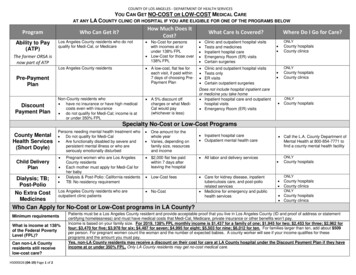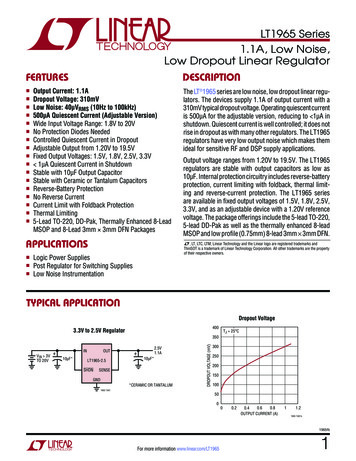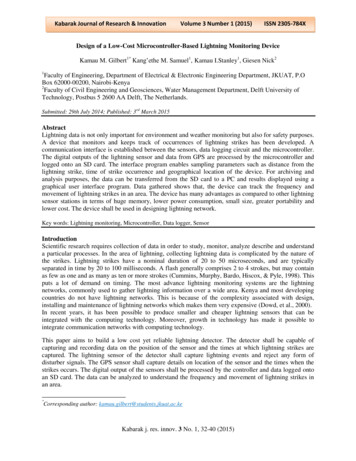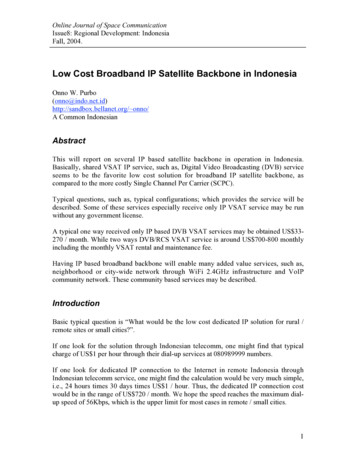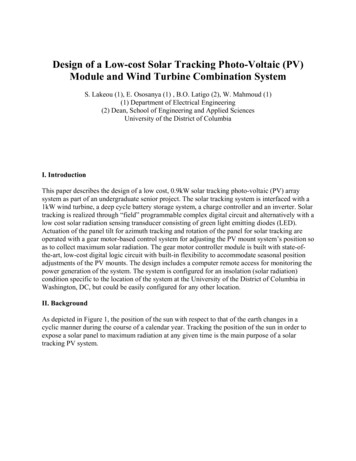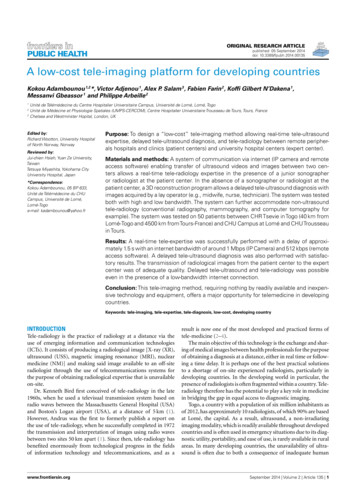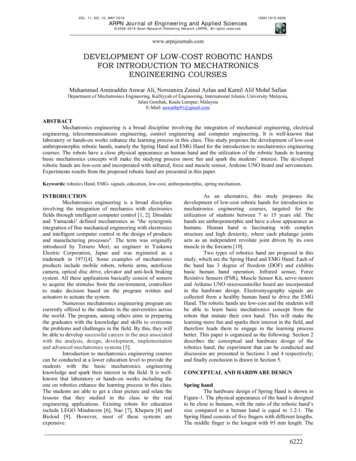
Transcription
VOL. 11, NO. 10, MAY 2016ISSN 1819-6608ARPN Journal of Engineering and Applied Sciences 2006-2016 Asian Research Publishing Network (ARPN). All rights reserved.www.arpnjournals.comDEVELOPMENT OF LOW-COST ROBOTIC HANDSFOR INTRODUCTION TO MECHATRONICSENGINEERING COURSESMuhammad Aminuddin Anwar Ali, Norsinnira Zainul Azlan and Kamil Alif Mohd SafianDepartment of Mechatronics Engineering, Kulliyyah of Engineering, International Islamic University Malaysia,Jalan Gombak, Kuala Lumpur, MalaysiaE-Mail: anwarbp91@gmail.comABSTRACTMechatronics engineering is a broad discipline involving the integration of mechanical engineering, electricalengineering, telecommunications engineering, control engineering and computer engineering. It is well-known thatlaboratory or hands-on works enhance the learning process in this class. This study proposes the development of low-costanthropomorphic robotic hands, namely the Spring Hand and EMG Hand for the introduction to mechatronics engineeringcourses. The robots have a close physical appearance as human hand and the utilization of the robotic hands in learningbasic mechatronics concepts will make the studying process more fun and spark the students’ interest. The developedrobotic hands are low-cost and incorporated with infrared, force and muscle sensor, Arduino UNO board and servomotors.Experiments results from the proposed robotic hand are presented in this paper.Keywords: robotics Hand, EMG- signals, education, low-cost, anthropomorphic, spring mechanism.INTRODUCTIONMechatronics engineering is a broad disciplineinvolving the integration of mechanics with electronicsfields through intelligent computer control [1, 2]. Dinsdaleand Yamazaki3 defined mechatronics as "the synergisticintegration of fine mechanical engineering with electronicsand intelligent computer control in the design of productsand manufacturing processes". The term was originallyintroduced by Tetsuro Mori, an engineer in YaskawaElectric Corporation, Japan and was registered as atrademark in 1971[4]. Some examples of mechatronicsproducts include mobile robots, robotic arms, autofocuscamera, optical disc drive, elevator and anti-lock brakingsystem. All these applications basically consist of sensorsto acquire the stimulus from the environment, controllersto make decision based on the program written andactuators to actuate the system.Numerous mechatronics engineering program arecurrently offered to the students in the universities acrossthe world. The program, among others aims in preparingthe graduates with the knowledge and skills to overcomethe problems and challenges in the field. By this, they willbe able to develop successful careers in the area associatedwith the analysis, design, development, implementationand advanced mechatronics systems [5].Introduction to mechatronics engineering coursescan be conducted at a lower education level to provide thestudents with the basic mechatronics engineeringknowledge and spark their interest in the field. It is wellknown that laboratory or hands-on works including theone on robotics enhance the learning process in this class.The students are able to get a clear picture and relate thelessons that they studied in the class to the realengineering applications. Existing robots for educationinclude LEGO Mindstorm [6], Nao [7], Khepera [8] andBioloid [9]. However, most of these systems areexpensive.As an alternative, this study proposes thedevelopment of low-cost robotic hands for introduction tomechatronics engineering courses, targeted for theutilization of students between 7 to 15 years old. Thehands are anthropomorphic and have a close appearance ashumans. Human hand is fascinating with complexstructure and high dexterity, where each phalange jointsacts as an independent revolute joint driven by its ownmuscle in the forearm [10].Two types of robotics hand are proposed in thisstudy, which are the Spring Hand and EMG Hand. Each ofthe hand has 3 degree of freedom (DOF) and exhibitsbasic human hand operation. Infrared sensor, ForceResistive Sensors (FSR), Muscle Sensor Kit, servo motorsand Arduino UNO microcontroller board are incorporatedin the hardware design. Electromyography signals arecollected from a healthy human hand to drive the EMGHand. The robotic hands are low-cost and the students willbe able to learn basic mechatronics concept from therobots that imitate their own hand. This will make thelearning more fun and sparks their interest in the field, andtherefore leads them to engage in the learning processbetter. This paper is organized as the following: Section 2describes the conceptual and hardware design of therobotics hand; the experiment that can be conducted anddiscussion are presented in Sections 3 and 4 respectively;and finally conclusion is drawn in Section 5.CONCEPTUAL AND HARDWARE DESIGNSpring handThe hardware design of Spring Hand is shown inFigure-1. The physical appearance of the hand is designedto be close to humans, with the ratio of the robotic hand’ssize compared to a human hand is equal to 1.2:1. TheSpring Hand consists of five fingers with different lengths.The middle finger is the longest with 95 mm length. The6222
VOL. 11, NO. 10, MAY 2016ISSN 1819-6608ARPN Journal of Engineering and Applied Sciences 2006-2016 Asian Research Publishing Network (ARPN). All rights reserved.www.arpnjournals.comindex finger and ring finger have same the lengths whichis 85mm, while the thumb and the little are 75 mm long.The Spring Hand is designed to accomplish grasping andfingertip pressing tasks so that the students will be able tolearn about different operation of the motors in executingvarious tasks. Each robotic finger is constructed with aspring and bones made of ABS plastics, using 3D printer.Spring is chosen so that the finger is flexible and possessesself-adaptability with wide range of objects’ shape. Thefinger bones are incorporated to enable a more stablepressing operation on the objects. The fingers are actuatedby three servo motors, installed in the palm and forearm.Servo motor 1 is used to pull the cable attached to thethumb. Servo motor 2 actuates the index finger and Servomotor 3 bends the remaining three fingers by pulling thecables that connect the fingers to the motor.An Arduino UNO is utilized as themicrocontroller board to acquire the input from the sensorsand controlling the motion of the servo motors. Twosensors are incorporated in the hardware development forautomatic operation of the hand, which are the infraredproximity sensor (IR sensor) and Force Sensitive Resistor(FSR). The IR proximity sensor, which provides digitalinputs, is used in detecting the presence of an object to begrasped under the palm without any physical contact. It isconnected directly to the digital input pin of the ArduinoUNO. The FSR, which provides analog inputs, isconnected to a voltage divider circuitry. The sensormeasures the force exerted by the robotic finger on variousobject with different stiffness. The voltage to the sensors issupplied from the Arduino UNO and the servo motors areconnected to the external power supply in parallel. Thecomplete electrical connection of the Spring Hand isillustrated in Figure-2.extraction and classification before being fed as an inputfor the robotic hand motion as shown in Figure-3.Since the raw EMG signal from hand muscle istoo small, which is between -5mV to 5mV it needs to beamplified. The signal also has to be filtered since it isusually mixed with the different types of noise that maycome from the equipment, electromagnetic radiation andmoving artifacts. In this work, these processes are doneusing a Muscle Sensor V3 Kit.Figure-4 shows the circuit of the Muscle SensorV3 Kit connected to an analog input pin of an ArduinoUNO in acquiring EMG signals. One of the advantages ofthis sensor kit is it can be used directly with amicrocontroller board such as Arduino Mega 2560 orArduino UNO. The output of the Muscle Sensor is not araw EMG signal, but rather an amplified, rectified andfiltered signal.Although a more complex feature extraction andclassification methods can be implemented, in this study asimple technique is applied for a simpler and fasterlearning process for the students. In this work, twocategories of hand motion are considered, which areopening and closing of whole hand, and the opening andclosing of the thumb and index finger only. Therefore,similar to the Spring Hand, the EMG Hand is actuated by3 motors, where each motor actuates the thumb, indexfinger and the rest of the three fingers.Based on the experiment conducted, theamplitude of the processed EMG signal is sufficient indistinguishing the relaxing state, whole hand, and thumband index finger closing and opening movements.Therefore, the feature is utilized to classify the handmotions in this work. The robotic hand moves accordingto the actual human hand motion as programmed by thestudents. However, the feature extraction andclassification method can be further extended toincorporate more hand motions and advanced methods fora higher level courses or syllabus.Figure-1. Spring hand hardware.EMG handIn the EMG Hand, the Electromyography (EMG)signal from the human hand muscle is collected to providethe input in driving the robotic hand motion. Surfaceelectrode will be used to acquire the EMG signal since thistype of electrode is safer and easier to be placed on thehand surface. The acquired raw EMG signal will gothrough amplification, rectification, filtering, featureFigure-2. Complete electrical connections of thespring hand.6223
VOL. 11, NO. 10, MAY 2016ISSN 1819-6608ARPN Journal of Engineering and Applied Sciences 2006-2016 Asian Research Publishing Network (ARPN). All rights reserved.www.arpnjournals.comEXPERIMENTSpring handExperiments have been conducted to test theperformance of the spring hand. The fingers of the handhave been developed using springs to provide theflexibility and adaptability of the hand in grasping variousshape objects as human hand. Figure-5 shows the graspingcapability of the Spring Hand on embroidery threads andsmartphone.(a)(b)Figure-5. Spring hand grasping (a) Embroidery threadsand (b) Smartphone.Figure-3. Processes undergone by the EMG signal.Figure-6 shows the triggered signal of the IRsensor for two cycles. The hand automatically grasps theobject beneath the hand as soon as it is detected by the IRsensor. The corresponding motion of the servo motors inrealizing grasping motion for two cycles can be observedin Figure-7. Equal input voltage supplies are provided toall motors to pull the strings in bending the fingers. In thisfigure, T1 2.8s, T2 3.0s and T3 2.8s. From thisexperiment, the students may learn how does the motorsoutput and motion would be affected by the input from thesensors.Figure-4. Muscle sensor kit connection.Figure-6. IR sensor triggered signal.6224
VOL. 11, NO. 10, MAY 2016ISSN 1819-6608ARPN Journal of Engineering and Applied Sciences 2006-2016 Asian Research Publishing Network (ARPN). All rights reserved.www.arpnjournals.comFigure-7. Motor motion with respect to the input fromthe IR sensor.(b)The Spring Hand has been tested to press objectswith different stiffness. In this test, the computer mouse,keyboard key and neck tie have been chosen shown inFigure-8 and the corresponding force response from theFlexi Force sensor can be observed in Figure-9. The fingerbones made of ABS plastic in the Spring Hand allow amore stable pressing on the objects.(c)Figure-8. Fingertip pressing of the spring hand on (a)computer mouse (b) keyboard and (c) neck tie.(a)From Figure-9, it can be seen that, the highestforce measured is the force exerted on the mouse andfollowed by the keyboard. The lowest maximum force wasthe force exerted on the neck tie. This result shows thedifferences in the force exerted by the hand, depending onthe stiffness of the object. The students may be able tolearn how the input from the sensor may vary withdifferent stimulus from the environment.EMG handTwo types of hand movements driven bydifferent EMG signals are considered in this experiment,which are the closing and opening of all fingers andclosing and thumb and index finger only6225
VOL. 11, NO. 10, MAY 2016ISSN 1819-6608ARPN Journal of Engineering and Applied Sciences 2006-2016 Asian Research Publishing Network (ARPN). All rights reserved.www.arpnjournals.comclassifying the fingers motion. All the 3 motors rotatewhen the Arduino detects an EMG signal of amplitude ofgreater than 6 mV to open all the fingers. If the amplitudeof the EMG signal is greater than 9 mV, only Motor 1 and2 are activated to actuate the thumb and index finger,whereas, all motors are stationary if the finger is atrelaxing state. In this experiment, the students will be ableto see the motion of the robotic hand in response to theirown hand’s motion. They will able to learn how thedifferent features in the input signal drive different motorsbased on the programming code and know how basicclassification process can be done.(a)(b)DISCUSSIONSThe students will be able to learn basic concept inmechatronics engineering using the proposed roboticshand. They will be able to see how the output of amechatronics system is influenced by the sensor, throughthe microcontroller. The variation in the sensor readingswith respect to different environment stimulus, the effectof the input signal on different motors and basicclassification process can also be observed clearly.The proposed robotics hand imitates the students’hand and therefore will be more interesting and fun to use.The classification method in the EMG hand can be furtherextended to accommodate higher level courses. Therobotics hands were constructed for less than USD200 andthis provides an alternative especially for institutions withlow financial resources. The next part of the work willinvolve the actual implementation of the robotic hands inclassroom to verify the effectiveness of the learningprocess using the robot, supported with rubrics
using a Muscle Sensor V3 Kit. Figure-4 shows the circuit of the Muscle Sensor V3 Kit connected to an analog input pin of an Arduino UNO in acquiring EMG signals. One of the advantages of this sensor kit is it can be used directly with a microcontroller board such as Arduino Mega 2560 or Arduino UNO. The output of the Muscle Sensor is not a raw EMG signal, but rather an amplified, rectified and .
